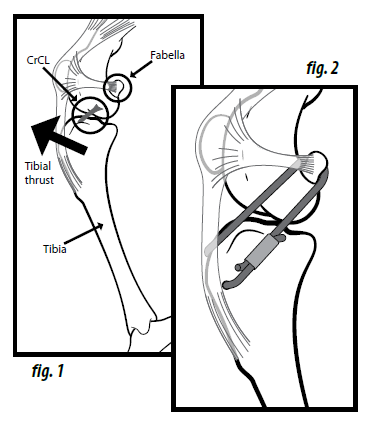Extracapsular Cranial Cruciate Stabilization

Suture Placement for Stabilization
Lateral Suture (Extracapsular Stabilization) of ruptured or injured cranial cruciate ligaments is an excellent method for return to function for many dogs. Ask Dr. Torok about whether or not your pet is a candidate for this procedure.
Learn More About What to Expect From Surgery Here
Cranial Cruciate Ligament And Points About Injury
The CrCL, sometimes called the anterior cruciate ligament (ACL), is an important joint stabilizer in the knee. It connects the femur (thigh bone) to the tibia (shin bone) and prevents the tibia from sliding forward during normal leg use (“thrust”). CrCL rupture is the most common source of knee problems in all sizes and breeds of dogs with all levels of activity. The ligament may be either fully or partially torn, but once damaged, has virtually no capacity to heal. Instability results, producing knee pain that manifests as lameness. Only surgery can restore proper limb stability and function.
How Does Extracapsular Lateral Suture Stabilization Work?
This technique prevents the tibia (shin bone) from thrusting forward relative to the femur (thigh bone). The tibia is sloped and the CrCL prevents this motion. This technique counters the mechanical force within the knee and prevents “thrust” (figure 1) from occurring. This is accomplished by placing a monofilament SECUROS suture around a small bone behind the femur (fabella) through a combination of small holes created in the femur and securing this with crimps. (figure 2)
Over the 8 week post-operative period, scar tissue is formed around the knee allowing for complete stabilization of the joint.
Will My Dog Have Surgery The Same Day As The Initial Consultation?
No, your pet will have a complete physical examination, X-rays and likely a sedated orthopedic exam as well. This allows for accurate diagnosis and helps ensure your pet’s anatomy is supportive of extracapsular stabilization. In addition, blood and urine testing with EKG will be performed prior to surgery to ensure your pet is healthy enough to safely undergo anesthesia.
How Long Is Recovery?
Your pet will need to be strictly rested for 8 weeks following surgery. This allows time for scar tissue formation and healing to occur. During this time, no “off-leash” activities are permitted. They will need to be kept away from slippery floors and will need to be leashed whenever they are outdoors. Stairs and furniture are not safe to traverse until your surgeon specifically tells you so.
When your dog is not in your immediate supervision, they should be confined to a crate or small room to avoid excessive activity which could compromise surgical outcome.
Learn More About Home Recovery Here
Is Physical Therapy Indicated After Surgery?
Just like a human, regaining strength in the muscles and regaining range of motion are crucial to a successful outcome. At-home exercises will be provided for you to accomplish daily, following discharge. There are times throughout the 8 week recovery to increase difficulty as your pet heals. Formal PT options are available as well which include underwater treadmill, swimming and coaching for sessions. This formal PT is offered by our veterinary partners.
Many of our patients elect to add on a package of laser therapy and joint protective injections (Adequan) for the initial 4 weeks post-operatively. The more you do for your pet during recovery, the more successful their outcome will be.
Is This a Suitable Option For Larger Dogs?
Extracapsular stabilization is most successful in small and medium dogs (<60 pounds). We have done many larger dogs with success as well, but statistically, there are fewer dogs corrected with this method. Anatomy is most important and if the slope of the tibia is too steep, then Dr. Torok will likely advise referral to a board certified veterinary surgeon for an alternate method of stabilization such as a TPLO (tibial plateau leveling osteotomy) or TTA (tibial Tuberosity Advancement). Both of these methods have metal implants placed to correct abnormal mechanical forces within the joint. Although these methods may carry greater risk of implant related complications, they are also very good options for many dogs.
What If We Don't Do Surgery?
There will always be some degree of arthritis in your dog’s knee as a result of the injury. Without surgery, persistent lameness and progressive arthritis will result. Decreased activity level, pain and poor function are almost certainties without surgical intervention.
How Much Does Surgery Cost?
Average cost for surgery varies with the age and size of your pet as well as any diagnostics that may have been done with your primary veterinarian prior to the consultation. A treatment plan will be created for you with specific recommendations for your pet at the time of your consultation with Dr. Torok.
Schedule Consultation